Optimizely on Optimizely: 5 Ways Personalization Can Supercharge Enterprise Marketing
Digital transformation has become a priority for large enterprises over the last five years. In fact, according to IDG’s State of Digital Business Transformation 2018, 89% of organizations have adopted or have plans for a digital-first strategy. In tandem, there is a growing need to improve digital experiences using experimentation and personalization. It’s no surprise

Michael O'Connell

Digital transformation has become a priority for large enterprises over the last five years. In fact, according to IDG’s State of Digital Business Transformation 2018, 89% of organizations have adopted or have plans for a digital-first strategy. In tandem, there is a growing need to improve digital experiences using experimentation and personalization. It’s no surprise then, that in recent years Optimizely’s enterprise customer base has grown significantly.
As a result, our product offerings and go-to-market efforts have adapted to better serve the needs of large enterprise customers. On the marketing front we’ve developed new channels and tactics to increase enterprise engagement and demand. One of these tactics has been to better leverage our own personalization product to engage visitors from enterprise accounts to our site. Personalization improves many of our site performance KPIs including landing conversion rates, as a result we have dozens of campaigns running at all times.
For B2B marketers, getting started with personalization can seem like a daunting task. It need not be and to help provide food for thought, outlined below are five tips to consider when deploying personalization as part of your enterprise marketing strategy:
1. Lead with strategy and success metrics
When considering personalization, it’s important to understand what success looks like from the getgo, and this starts with the metrics and KPIs you are trying to influence.
At Optimizely, we use personalization to impact our marketing funnel metrics. The top priority is to improve our visit-to-conversion rate and drive more leads from named enterprise accounts A secondary goal is to increase site engagement, for which we look at metrics like bounce rates from named enterprise accounts and average pages per session.
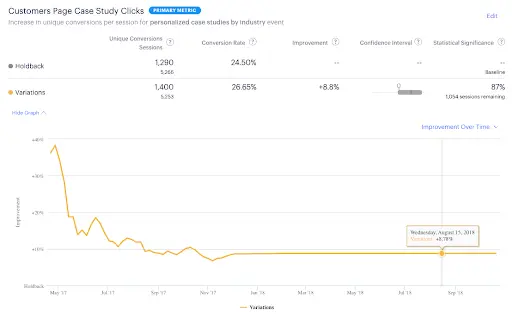
It’s important to understand what metrics personalization can help you improve.
2. Personalization isn’t just for consumers
Website personalization has multiple use cases for B2B marketers. For example, if a developer visits your site, then chances are they will be more interested in receiving the offer of a product trial or developer docs, versus a demo from a sales rep.
Overall, role-based personalization can be harder to achieve; a good starting point is using firmographic data such as industry, geographic data, etc. With this information you can deliver curated content recommendations for your site visitors and gain a significant increase in click-throughs for these campaigns.
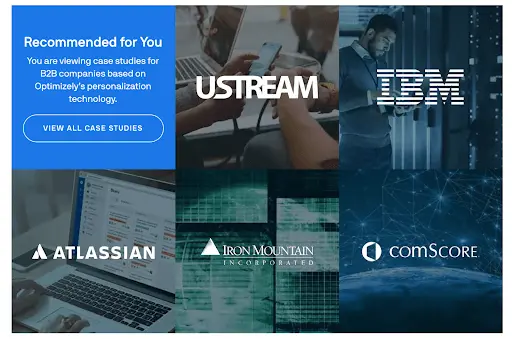
By showing personalized content offers for based on a visitor’s industry, Optimizely saw a 40% increase in clicks.
3. Use symmetric messaging in ad campaigns / What you see is what you get
With symmetric messaging you change the content on a page in real time to mirror the language that was used in the ad that drove the target buyer there. In addition to being a more seamless brand encounter, it can also help drive increased landing page conversion rates.
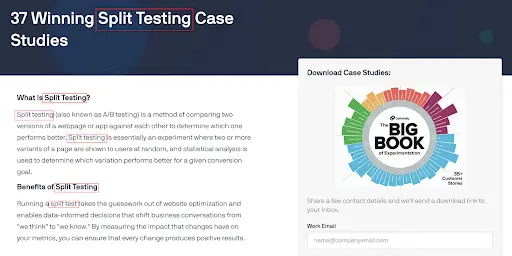
Symmetric messaging can improve your visitor experience and boost your AdWords quality score.
4.Create personalized offers and experiences for top target accounts
There are varying degrees of personalization marketers can apply to an enterprise strategy, and for a list of the top 10 or even 20 accounts, personalization can be used to create a premium, white-glove experience as part of an Account Based Marketing (ABM) strategy.
You could make the entire homepage experience customized to these target brands, with images of their offices or products, with relevant copy, and chatbots available, delivering a premium look and feel.
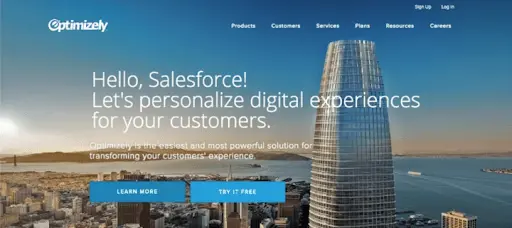
In this example, we have personalized the homepage for Salesforce, which we were again able to determine through firmographic data based reverse-IP lookup.
5. Choose the right data sources to power personalization efforts
The most commonly used data by B2B marketers is firmographic data from vendors such as Demandbase, Clearbit and Bombora. More advanced users will combine these data sources with other proprietary and third-party sources using a Data Management Platform (DMP) such as Tealium or Krux or a Customer Data Platform (CDP) such as Segment or mParticle.
At Optimizely, we have 40 personalization campaigns running on our site, and the majority are powered by Demandbase firmographic data. We also have more advanced use cases that leverage other data sets, but often, simple is best.
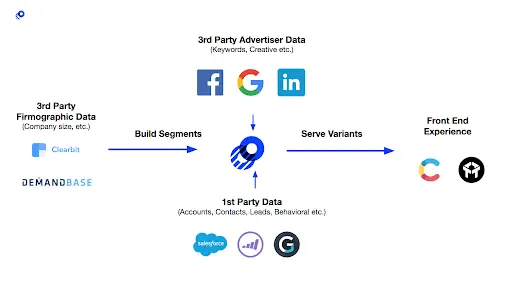
Optimizely has made investments in a number of 3rd party data sources such as Clearbit and Demandbase.
Takeaways
The use of personalization incorporated into an enterprise marketing program can drive positive ROI quickly. Rather than just diving straight in, set your goals, choose your data sources wisely and, where possible, try before you buy. Finally, one thing we believe strongly is to treat personalization as an experiment – one that should be iterated on in order to come to the best outcome.
For more guidance on how to leverage technology to create a high performing personalization strategy, check out our webinar, B2B Experimentation and Personalization at Optimizely.
